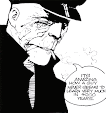 Unit Seven was Study of Industry Practice, which was a useful way of accumulating a fair bit of knowledge about how films are financed and produced, but which hasn't really had much of an impact on my writing since.
Unit Seven was Study of Industry Practice, which was a useful way of accumulating a fair bit of knowledge about how films are financed and produced, but which hasn't really had much of an impact on my writing since.For the unit, we were given a feature-length script by one of the previous year's MA graduates and asked to write a 2,000-word report describing its potential for production and sales in the world marketplace.
In support of the unit, we were given a lengthy and thorough lecture by Tom Strudwick - a highly experienced film sales and marketing consultant.
(Tom also hosted a thoroughly bruising pitch session before we handed in our major project proposals - the only time over the two years of the MA that I didn't want to play any more.)
Anyway, Tom guided us through assessing a project at script stage from both creative and marketing perspectives - particularly the art of 'positioning' a film: ie, defining its key audience and working out how the film could be effectively marketed to it.
Perhaps most usefully, he stressed throughout the importance of knowing what you're selling (at whatever stage of development or production it's at) and being able to describe it as succinctly as possible to the next link in the chain.
What he said seemed to equate to the importance that Blake 'Save the Cat' Snyder puts on the idea of 'what is it?': A movie must have a clear sense of what it's about and who it's for. Its tone, potential, the dilemma of its characters and the type of characters they are should be easy to understand and compelling.
We also had a look at the importance of genre and generic conventions in film marketing. For instance, Peter Mullan's The Magdalene Sisters would normally have been a tough sell to the mass audience (drama/older audience/female-skewed). However, it broke through after being marketed in the same generic terms as a prison movie.
After looking at publicity and promotion, we also had a brief introduction to the various models of film finance (including 'soft money', co-production, distribution, etc), as well as other factors that would influence production, such as regional incentives and assessing the scale of the enterprise.
I think the script we assessed is in development somewhere, so I won't post my essay. Because of the rapidly changing finance and production environment, most of the resources I used were online - especially articles from journals. However, here's the brief resource list we were given for the unit:
Trade Press
- Screen International
- Variety
- The Hollywood Reporter
- Screen Finance
- Dealmaking in the Film and Television Industry – Mark Litwak (Silman-James Press)
- The Guerilla Film Makers Handbook - Chris Jones and Genevieve Joliffe (Continuum International Publishing)
- The Guerilla Film Makers Movie Blueprint – Chris Jones
- The Movie Business Book - Jason E. Squire (Virgin Books)
- Film Budgeting – Ralph S. Singleton (Lone Eagle)
- The Big Deal - Thom Taylor (Quill)
- David Puttnam: My Story So Far - Andrew Yule (Time Warner)
- Final Cut - Stephen Bach (Faber)
- My First Movie - Stephen Lowenstein (Faber)
- Rebel Without A Crew - Robert Rodriguez (Faber)
- Money into Light – John Boorman (Faber)
- Projections – John Boorman and Walter Donahue (Faber)


2 comments:
Thank you for another interesting and insightful post about your studies.
Makes me want to take a screenwriting MA!
It certainly sounds as if it was well worth the time and money doing it though. You sound like a pro! :)
Thank you also for all the book lists you give. Very helpful :)
That's very kind of you - whenever I read any of these posts again, I worry that I sound like a tedious old stoat (when, of course, I'm famously vivacious, bubbly and playful in real life).
Post a Comment